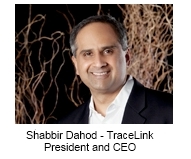 The buzz around serialisation and track-and-trace initiatives in the pharmaceutical industry has largely been focused on protecting the downstream supply chain from counterfeiting and diversion, but companies are increasingly looking at the business benefits upstream as well.
The buzz around serialisation and track-and-trace initiatives in the pharmaceutical industry has largely been focused on protecting the downstream supply chain from counterfeiting and diversion, but companies are increasingly looking at the business benefits upstream as well.
That was the message from Shabbir Dahod, chief executive of traceability specialist TraceLink, who told SecuringPharma.com in a recent interview that companies are increasingly applying track-and-trace across the supply chain, including internal product flows and processes to improve management and visibility of production.
Events such as the heparin contamination scandal of 2008 have made companies and regulatory authorities look into ways to trace the origin of raw materials back to source when an adverse reaction or other issue emerges with a pharmaceutical product.
TraceLink says its system can help drugmakers identify the material suppliers, contract manufacturers and other links in the supply chain in real time, right down to the batch level.
Up until recently, TraceLink's business was very much focused on track-and-trace in the downstream supply chain, and it had already chalked up a number of clients in Big Pharma such as Pfizer and Novartis, as well as players in the broader medicines distribution chain such as retailers, distributors, re-packers and others.
"We realised our customers are moving towards a virtual execution of production rather than the classical vertically-integrated model and are outsourcing far more," said Dahod. "That prompted us to develop a solution which can be applied upstream which we launched earlier this year."
That said, TraceLink is also seeing resurgence in interest in downstream serialisation with the deadline for California's ePedigree requirement now on the horizon.
"Until recently life science companies - almost universally - had a firewall between upstream and downstream and really thought about them as completely separate areas of their business," added Brian Daleiden, TraceLink's vice president of marketing.
"In the last six months it has become clear that companies are now viewing this as a holistic chain, from the raw material to the manufacturing, packaging and distribution of the product."
"We're seeing a convergence of the two areas," said Dahod, noting that this is exactly the rationale behind TraceLink's recently-signed agreement with US contract packaging specialist Sharp Corp.
In addition to upstream elements such as production tracking, review of inventory, material tracking and a host of other processes, Sharp is also looking to collaborate more with its customers on large-scale serialisation, which taps into what TraceLink is doing downstream with product tracking.
"Sharp is already offering serialisation to its customers, but the process is very much coordinated through phone, fax and email at the moment," said Dahod. "In order to scale that for industry-wide serialisation, we need to move towards a system-based solution, rather than a people-based solution."
Serialisation challenges
"Oftentimes people believe the challenge in serialisation is in how you get a number of a package, but in reality the information system needed to commission, share, update and coordinate the serial numbers is the main hurdle to overcome," according to Dahod.
Whether the approach relies on pre-printing serial numbers on packs or printing and verifying them in-line, "there are a lot of business processes, workflows and information exchange that need to be coordinated to make serialisation successful in an integrated supply network," he added.
Dohad noted that this is the "unsolved problem" in the industry at the moment, particularly in cases where a pharmaceutical manufacturer is making use of a contract packager such as Sharp.
The need to link up two companies' internal information systems in order to allow high-level interaction - ideally in real-time - is an enormous and underestimated challenge which becomes even more so when the requirements of individual countries or regions are considered.
In some markets for example, serial numbers are supplied by the national regulatory authority or must be communicated to the regulator once generated, adding another dimension to the complexity of the system.
Coding initiatives in other countries such as Brazil, Turkey and China have in fact made the pharmaceutical industry's approach to serialisation much more overarching now than it was a few years back, before California extended its deadline from 2011 to 2015.
"The last time around industry was looking at a US serialisation solution, and now they are looking at a global solution, helped by what seems to be convergence around GS1 standards, with the possible exception of China which could turn out to be an outlier in this regard," said Dahod.
Related articles:
Serialisation consortium reborn as coding mandates approach
TraceLink and Catalent link up on supply chain
TraceLink buy refocuses SupplyScape
©
SecuringIndustry.com




 The buzz around serialisation and track-and-trace initiatives in the pharmaceutical industry has largely been focused on protecting the downstream supply chain from counterfeiting and diversion, but companies are increasingly looking at the business benefits upstream as well.
The buzz around serialisation and track-and-trace initiatives in the pharmaceutical industry has largely been focused on protecting the downstream supply chain from counterfeiting and diversion, but companies are increasingly looking at the business benefits upstream as well.